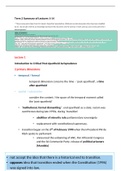Summary
FSAL SUMMARY UCT: Term 2 summary of lectures 1 to 14 (42 PDF PAGES SUMMARISING OVER 143 SLIDES) SAVE TIME
- Institution
- University Of Cape Town (UCT)
-are the powerpoints too long and you can't manage to go through all of them? -is it difficult to summarise and chose what's important in the FSAL powerpoints? look no further -42 PAGES SUMMARISING 143 SLIDES, SAVE TIME -14 lectures summarised - colourised, no points repeated -highligh...
[Show more]



